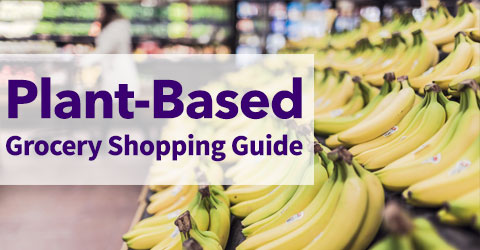

Plant-Based Shopping is actually easier than you think! This list is intended as a resource to help you get started. Keep in mind that food product formulations do change, so it is wise to read labels. These products are not endorsed by the T. Colin Campbell Center for Nutrition Studies.
Fresh Produce (Fruits and Vegetables)
Enjoy a wide variety of fruits and vegetables! Choose plenty of dark leafy greens.
Beans and Legumes
Enjoy ALL varieties of dried beans and lentils. If you buy canned beans, look for low-sodium or no-salt. If you can’t get no-salt added, rinse the beans well with water prior to use.
Nuts, Seeds, and Dried Fruits
If you do choose to purchase nuts, any variety is ok but look for raw and no oil-added. Avoid eating by the handful as they are high fat and high calorie and very easy to overeat. Use nut butters sparingly.
Omega-3 rich chia and flax seeds can used to top cereal and replace eggs in baked goods (1 tbsp chia or ground flaxseed plus 3 tbsp water = 1 “egg”). Whole flax seeds are not digested so it is best to buy ground flax seeds or even better, grind them right before use in a coffee grinder. Use other seeds (sesame, pumpkin, sunflower) sparingly.
Most dried fruits are acceptable when they are eaten sparingly and do not have added sugar. Keep in mind they are higher in calories than fresh fruits. If you are diabetic or trying to lose weight, eat fresh fruits rather than dried fruits. Avoid dried banana chips as most are actually fried.
Frozen Foods
All varieties of frozen vegetables and fruits without added oil or dairy ingredients.
Breads
Choose breads that are 100% whole grain with no oil added or less than 10% calories from fat. Enriched wheat flour, unbleached wheat flour, wheat flour, and organic wheat flour are not whole grain. Some options are:
Whole Grains
There are a very large variety of whole grains to choose from including: rice, quinoa, farro, spelt, bulgur, millet, hull-less barley, whole grain polenta or coarse cornmeal, oatmeal, teff and more. Whole grain rice options include: short, medium, and long grain, basmati, jasmine, black, wild red and even purple! Choose from any variety but make sure to avoid white rice.
Whole Grain Flours
There are a variety of flours to choose from including:
You can also use gluten-free flours if wheat allergies are an issue but make sure to read the label carefully that they contain only whole grains. Many gluten-free products are highly processed.
Pastas
Any 100% whole wheat or brown rice pasta (other grains are ok – spelt, quinoa, etc – but read carefully to make sure it is entirely whole grain)
Breakfast Cereals
Choose minimally sweetened, whole grain cold and hot cereals without added oil. Some examples are:
Non-Dairy “Milks”
Choose unsweetened or minimally sweetened non-dairy beverages. Avoid products with oils in the ingredient list. Avoid oat non-dairy beverages (very high sugar). Some options are:
Tomato and Pasta Sauces
Choose sauces with no animal products, no added oil or 10% or fewer calories from fat, minimal sugar, and lower sodium when comparing products.
Prepared Salad Dressings
Choose dressings with no added oil or less than 10% calories from fat, minimal sugar, and lower sodium when comparing products.
Flavor “Boosters”
There are many options to boost the flavor of your food without adding any fat or sugar including:
Convenience Foods
The following are some options for convenience foods:
Chips and Crackers
There are a variety of options to choose from. Avoid kale and vegetable “chips” made with oil. Also avoid kale chip that are high in fat due to nuts and tahini if you are trying to lose weight.
Cheese Substitutes
Try nutritional yeast for sprinkling on pasta and using in recipes for “cheesy” flavor.
For special occasions options include:
Miyoko’s Creamery cheeses (choose the no added oil varieties)
Treeline Tree Nut Cheeses
These are high in fat so using sparingly.
Meat Substitutes
Use as you transition if you want a meaty texture and flavor but avoid using daily:
Copyright 2025 Center for Nutrition Studies. All rights reserved.